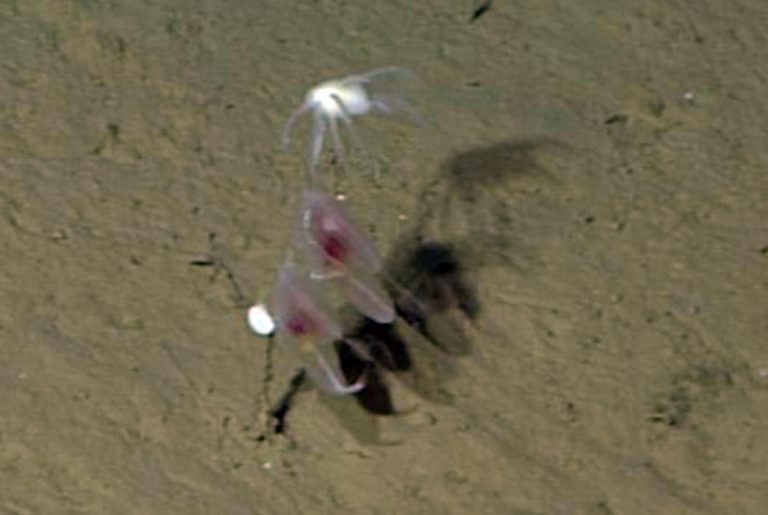DIVING NEWS
The first instance of a deep-sea sponge with the ability to create its own light has been reported by deep-sea researchers – following a chance “touch” in the laboratory.
Scientists from the Monterey Bay Aquarium Research Institute (MBARI) had deployed their Don Ricketts ROV over the 4km-deep seabed 100 miles off the California coast when its camera picked up the sponge anchored in the mud.
Also read: SPONGES: GLUE OF THE REEF, Viruses bow to killer sponges and Secret upwardly mobile life of sponges
Researchers had been seeing the unnamed species on the seabed for decades, from the Canadian Arctic to the Gulf of Mexico and around the Hawaiian Islands, but had never studied them before. The specimen was collected only to study a ctenophore on its surface.
Brought to the surface, the animal was placed in the darkened laboratory aboard the research vessel Western Flyer – where, to the researchers’ surprise, a gentle touch caused it to emit a blue-green glow.
“The sponge was left in the sampler after everybody picked animals of interest,” said the scientist who made the discovery, Séverine Martini of the Mediterranean Institute of Oceanography in Marseille.
“I was working on the benthic list of bioluminescent organisms at that time and tested everything I could. I decided to try this one; we had no idea what it was at that time. When I stimulated it, it was clearly bright and lasting for several seconds.”
Many deep-sea animals glow, but sponges had always been considered an exception before. Some that appeared luminous turned out to contain glowing bacteria, or had eaten or been colonised by bioluminecent animals – which is how so many deep-sea animals are able to shine.
Martini, with study co-author Carrin Schultz of the University of California and MBARI marine biologists has now demonstrated that the sponge contains coelenterazine, the key chemical needed to create light, as used by other marine organisms from jellyfish to cephalopods.
“This finding is pretty spectacular evolutionarily in that we don’t know of any other sponge that has been shown to use coelenterazine, let alone clearly shown to be bioluminescent,” said Schultz.
The ROV cameras had not been sensitive enough to detect light coming from the sponge and five others collected later, but a low-light video camera was able to capture the top, filaments and stalk of each sponge glowing brightly enough when touched to be easily visible to the naked eye for 5-10 seconds.
The initial discovery was made in 2017, although the study has been published only this month in Frontiers in Marine Science.
“After Séverine identified that the sponges were bioluminescent, it took us several years and three research expeditions to piece together what was going on biochemically,” said Schultz. “During each cruise, we could only collect two or three sponges… in the end, all of the evidence pointed toward the sponge not using a bacterial symbiont for bioluminescence but using chemicals and enzymes from its own cells to produce light.
“In the future, we will determine if the genes required for bioluminescence are encoded in the sponge genome, and will use that information to learn more about how this species evolved the ability to make its own light.”
The researchers hope to establish what benefit the sponges derive from being bioluminescent only on contact – whether it’s a tactic to deter predators or to attract prey. With food scarce in the deep ocean, such sponges have evolved to be carnivorous, catching passing prey on tiny hooks on their surface.

